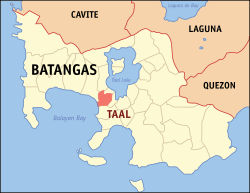Our website is made possible by displaying online advertisements to our visitors.
Please consider supporting us by disabling your ad blocker.
Taal, Batangas
Taal | |
|---|---|
| Municipality of Taal | |
 Minor Basilica of Saint Martin of Tours | |
 Map of Batangas with Taal highlighted | |
Location within the Philippines | |
| Coordinates: 13°53′N 120°56′E / 13.88°N 120.93°E | |
| Country | Philippines |
| Region | Calabarzon |
| Province | Batangas |
| District | 1st district |
| Founded | April 26, 1572 |
| Barangays | 42 (see Barangays) |
| Government | |
| • Type | Sangguniang Bayan |
| • Mayor | Fulgencio I. Mercado |
| • Vice Mayor | Michael Rey A. Villano |
| • Representative | Joseph Eric R. Buhain |
| • Municipal Council | Members |
| • Electorate | 38,386 voters (2022) |
| Area | |
• Total | 29.76 km2 (11.49 sq mi) |
| Elevation | 63 m (207 ft) |
| Highest elevation | 194 m (636 ft) |
| Lowest elevation | 0 m (0 ft) |
| Population (2020 census)[3] | |
• Total | 61,460 |
| • Density | 2,100/km2 (5,300/sq mi) |
| • Households | 14,977 |
| Economy | |
| • Income class | 3rd municipal income class |
| • Poverty incidence | 9.45 |
| • Revenue | ₱ 259.1 million (2022) |
| • Assets | ₱ 479.7 million (2022) |
| • Expenditure | ₱ 212.2 million (2022) |
| • Liabilities | ₱ 73.12 million (2022) |
| Service provider | |
| • Electricity | Batangas 1 Electric Cooperative (BATELEC 1) |
| Time zone | UTC+8 (PST) |
| ZIP code | 4208 |
| PSGC | |
| IDD : area code | +63 (0)43 |
| Native languages | Tagalog |
Taal [ta'ʔal], officially the Municipality of Taal (Tagalog: Bayan ng Taal), is a municipality in the province of Batangas, Philippines. According to the 2020 census, it has a population of 61,460 people.[3]
Taal is famous for its old ancestral houses, one particular ancestral house (now a museum) where Marcela Coronel Mariño de Agoncillo grew up in Taal, Batangas built in the 1770s by her grandparents, Don Andres Sauza Mariño and Doña Eugenia Diokno Mariño. Its poblacion (town proper) is designated as a National Historical Landmark.[5] The municipality is known as the balisong and barong tagalog capital of the Philippines. The town is home to hundreds of heritage structures dating from the Spanish colonial period. Scholars have been pushing for its inclusion in the UNESCO World Heritage List.
- ^ Municipality of Taal | (DILG)
- ^ "2015 Census of Population, Report No. 3 – Population, Land Area, and Population Density" (PDF). Philippine Statistics Authority. Quezon City, Philippines. August 2016. ISSN 0117-1453. Archived (PDF) from the original on May 25, 2021. Retrieved July 16, 2021.
- ^ a b Census of Population (2020). "Region IV-A (Calabarzon)". Total Population by Province, City, Municipality and Barangay. Philippine Statistics Authority. Retrieved July 8, 2021.
- ^ "PSA Releases the 2021 City and Municipal Level Poverty Estimates". Philippine Statistics Authority. April 2, 2024. Retrieved April 28, 2024.
- ^ NHCP Historic Preservation Division. "Portion of the Town of Taal". National Registry of Historic Sites & Structures in the Philippines. Retrieved on July 3, 2013.
Previous Page Next Page





